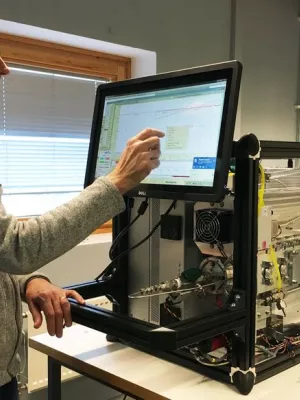
Erik Swietlicki
Professor

Yearly trend of dicarboxylic acids in organic aerosols from south of Sweden and source attribution
Author
Summary, in English
Seven aliphatic dicarboxylic acids (C3-C9) along with phthalic acid, pinic acid and pinonic acid were determined in 35 aerosol (PM10) samples collected over the year at Vavihill sampling station in south of Sweden. Mixture of dichloromethane and methanol (ratio 1:3) was preferred over water for extraction of samples and extraction was assisted by ultrasonic agitation. Analytes were derivatized using N,O-bis(trimethylsilyl)trifluoroacetamide (BSTFA) containing 1% trimethylsilyl chloride and analyzed using gas chromatography/mass spectrometry. Among studied analytes, azelaic acid was found maximum with an average concentration of 6.0 +/- 3.6 ng m(-3) and minimum concentration was found for pimelic acid (1.06 +/- 0.63 ng m(-3)). A correlation coefficients analysis was used for defining the possible sources of analytes. Higher dicarboxylic acids (C7-C9) showed a strong correlation with each other (correlation coefficients (r) range, 0.96-0.97). Pinic and pinonic acids showed an increase in concentration during summer. Lower carbon number dicarboxylic acids (C3-C6) and phthalic acid were found strongly correlated, but showed a poor correlation with higher carbon number dicarboxylic acids (C7-C9), suggesting a different source for them. Biomass burning, vehicle exhaust, photo-oxidation of volatile organic compounds (natural and anthropogenic emissions) were possible sources for dicarboxylic acids. (C) 2012 Elsevier Ltd. All rights reserved.
Department/s
- Centre for Analysis and Synthesis
- Department of Physics
- Nuclear physics
- MERGE: ModElling the Regional and Global Earth system
Publishing year
2012
Language
English
Pages
197-204
Publication/Series
Atmospheric Environment
Volume
57
Document type
Journal article
Publisher
Elsevier
Topic
- Meteorology and Atmospheric Sciences
Keywords
- Dicarboxylic acids
- Ultrasonic assisted solvent extraction
- Correlation
- coefficient
- Biomass burning
- Photo-oxidation
- Phthalic acid
- Pinonic
- acid
Status
Published
ISBN/ISSN/Other
- ISSN: 1352-2310